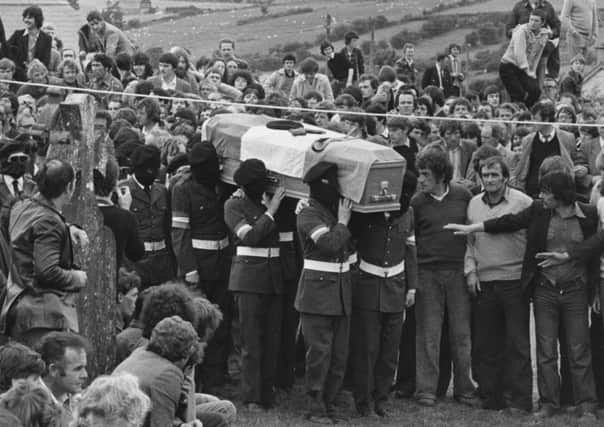Soviet Union ‘was ready to exploit IRA’ in Cold War


State papers published today under the 30-year rule have revealed that ahead of a one-day visit to Dublin in 1983 from the then US vice-president, officials said the Taoiseach should use the Soviet threat as a way of getting support.
The advice was offered amid planning for the Fourth of July arrival but White House aides were less preoccupied with the Northern Ireland question and more on arrangements for a “spontaneous meet-the-people” stop for Mr Bush in a pub. But seeing an opportunity to get Washington on board with the political situation, advisors to Garrett FitzGerald and minister for foreign affairs Peter Barry urged them to use the growing terror threat and closeted support for the Provisional IRA to drum up interest.
Advertisement
Hide AdAdvertisement
Hide Ad“It is suggested that the Taoiseach and the minister, rather than stressing the fact that Sinn Fein made little or no gains in the recent election, should on the other hand emphasise the present serious level of support and the opportunities which this creates for subversion and indeed outside [Soviet] exploitation,” documents revealed.
The steering note in files from the Department of Foreign Affairs said that Dublin felt the British government was not taking the Northern Ireland question seriously.
Officials told the Taoiseach to warn vice-president Bush that Sinn Fein was becoming an increasing left wing party and that nationalists were feeling increasingly alienated from the political process in Northern Ireland.
The papers also revealed Ireland agreed to ban Soviet airlines from the tarmac at Shannon airport just ten days before nuclear catastrophe was avoided during the Cold War.
State papers show US president Ronald Reagan sent a direct request for Taoiseach Garret FitzGerald to stop Aeroflot stopovers after a civilian airliner was blown out of the sky.
The blanket ban was ordered after the Soviets shot down Korean Air Lines Flight 007 on 1 September, 1983 near Sakhalin island in the Sea of Japan, after it strayed into Russian air space.
All 269 passengers and crew, including US congressman Larry McDonald, were killed.
In a strongly worded two-page letter, Mr Reagan tried to rally international opposition to the Soviets and called for co-operation and support among friends.
Advertisement
Hide AdAdvertisement
Hide Ad“The Soviet action represents a challenge to the international community. It would be a tragedy if we do not collectively respond in a resolute and clear manner to this action,” he wrote.
Within weeks Cold War tensions were at their highest since the Bay of Pigs crisis in 1962.
According to leaked reports, the world was a red button away from a nuclear World War Three after a Russian army early warning missile detection system gave a false alarm that the US had launched a strike.
A month or so later as the Kremlin attempted to keep the technical breakdown quiet while continuing its spy operations, enemies in Nato cranked tensions to their peak by simulating the early stages of nuclear war in operation Able Archer.
The period is regarded by many military and political historians to be the closest the world came to nuclear war.
Mr FitzGerald confirmed Aeroflot would be banned from Shannon on 16 September, 1983, ten days before the fault in the Oko missile detection system in Moscow.
State papers labelled Ian Paisley ‘schizophrenic’
Ian Paisley was described as a schizophrenic ready to adopt the IRA’s “Brits out” mantra if he did not get his way on Northern Ireland politics, state papers claim.
According to a report marked “secret” and released under the 30-year rule, then secretary of state for Northern Ireland James Prior believed that the Democratic Unionists were less prone to splits and division because of the leader’s domination.
Advertisement
Hide AdAdvertisement
Hide AdHis hardline views on Mr Paisley were recorded in the Irish Department of Foreign Affairs files following a meeting with minister for foreign affairs Peter Barry at Hillsborough on 19 October, 1983.
“Mr Prior said that there were people like Paisley who were schizophrenic,” a report of the meeting shows.
“The DUP were loyalists only so long as they got their own way and would as a last resort get the ‘Brits out’ and go it alone rather than seek accommodation with the minority.”
Queen confused over country’s name
The Queen used the wrong name for the Republic of Ireland when writing to president Patrick Hillery, according to a note from 1983.
Despite all the diplomatic hoops that have to be jumped through when heads of state communicate with each other, the newly released papers reveal a glaring error which was picked up by a senior civil servant and adviser on presidential affairs.
In extravagantly worded letters to President Hillery in 1983, Her Majesty marked the changing of the ambassadorial guard in Dublin.
In the note personally signed by the Queen, she used “Irish Republic” rather than Republic of Ireland.
Pat O’Sullivan, government secretariat in 1983 and adviser to Garrett FitzGerald on matters relating to the president, spotted the mistake and asked for the views of the Department of Foreign Affairs.
The 1948 Republic of Ireland Act declared that the state should be referred to as the Republic of Ireland.